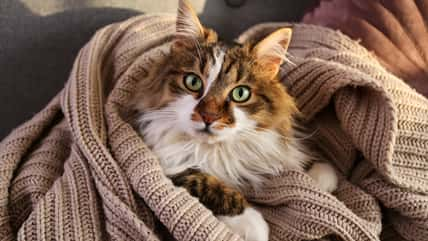Here’s Everything You Need To Know To Help Your Cat With Hairballs And Prevent Them From Wreaking Havoc On Your Feline Friend

Cats are beloved for their mysterious nature and impeccable grooming habits. Yet, this meticulous self-cleaning also comes with its own set of challenges– most notably, hairballs.
These seemingly innocuous clumps of hair are more than just a nuisance; they can be indicative of your cat’s health and well-being.
So, understanding and managing hairballs is essential for any cat owner, ensuring their feline friends lead a comfortable and happy life.
The Basics Of Hairballs
Hairballs, medically known as trichobezoars, are not actually balls but rather tightly packed, elongated clumps of hair. They form as a result of your cat’s grooming routine.
Cats have tiny hook-like structures on their tongue that catch loose and dead hair, which is then swallowed. While most of this hair passes through the digestive tract without issue, some can remain in the stomach and form a hairball.
Why Cats Get Hairballs
Now, while the root cause of hairball formation lies in the cat’s innate grooming behavior, there are several other factors that can exacerbate their occurrence.
First up is your cat’s breed and fur length. Long-haired breeds like Persians and Maine Coons are more susceptible due to the sheer volume of hair they shed.

Africa Studio – stock.adobe.com – illustrative purposes only, not the actual person or cat
Next is seasonal shedding– when, during certain times of the year, increased shedding can lead to more frequent hairballs.
Lastly, behavioral issues, stress, or skin irritations can all lead your cat to excessively groom itself, ultimately increasing hair ingestion.
Diagnosing And Treating Hairballs
When hairballs become a regular issue, it’s time to consult with a veterinarian. A thorough examination can help rule out other conditions that might mimic or contribute to hairball symptoms, such as digestive blockages or dietary sensitivities.
Then, treatment strategies can vary widely, from dietary changes to enhance fiber intake and improve gastrointestinal health, to surgical intervention in severe cases where hairballs cause intestinal blockages.
Home Remedies And Preventative Measures
In addition to professional veterinary care, there are also several home remedies and preventative measures to help manage hairball formation.
Primarily, over-the-counter hairball remedies, available in the form of pastes or gels, often contain petroleum jelly or vegetable oils designed to lubricate the ingested hair. This facilitates its passage through the cat’s digestive system and helps prevent the accumulation of hair in the stomach that leads to the formation of hairballs.
Furthermore, there are actually specialized cat foods formulated to combat the issue of hairballs. These diets are rich in fiber, which plays a crucial role in promoting the movement of hair through the gastrointestinal tract, thus reducing the chances of hairball formation.
Alongside dietary management, consistent grooming habits are crucial in controlling the amount of hair swallowed by the cat during its grooming sessions.
Regular brushing, especially for long-haired breeds, not only minimizes the ingestion of hair but also contributes to the overall health of the cat’s coat. So, daily grooming sessions may be necessary for certain breeds to effectively manage the shedding and prevent excessive hair ingestion.
Finally, maintaining proper hydration and a balanced diet is essential in ensuring the cat’s digestive system operates efficiently.
Access to fresh water at all times, coupled with a nutritionally complete diet, supports digestive health and can significantly diminish the likelihood of hairball development.
Behavioral Insights
It also doesn’t hurt to pay attention to your cat’s grooming habits and, if necessary, modify them.
After all, stress and anxiety can lead to over-grooming. That’s why providing a calm, enriching environment is essential. You can also engage your cat in regular play and ensure they have safe, comfortable spaces to retreat to.
Sign up for Chip Chick’s newsletter and get stories like this delivered to your inbox.
More About:Animals





